Ib chem Guías de estudio, Notas de estudios & Resúmenes
¿Buscas las mejores guías de estudio, notas de estudio y resúmenes para Ib chem? En esta página encontrarás 304 documentos de estudio para Ib chem.
Libros populares 'Ib chem'
Todos los libros 3 OcultarAll 304 resultados
Ordenador por
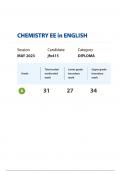 Popular
Popular
-
IB Chemistry Extended Essay (Graded A, 31/34) - Investigating the Influence of inorganic electrolytes on the phase-inversion temperature of an anionic surfactant-bound oil-in-water macro emulsion.
- Presentación • 42 páginas • 2023
-
- $25.49
- 2x vendido
- + aprende más y mejor
This is a 31/34 IB Chemistry Extended Essay which scored an A for the M2023 session. Chemistry is arguably the most challenging subject to write an Extended essay about which is why a high-level example is crucial in inspiring you're topic and guiding you through the writing process. I worked way too hard writing this essay and if I would have had an original example to base my work on writing it would have been effortless. The Essay investigates the Influence of inorganic electrolytes on the ph...
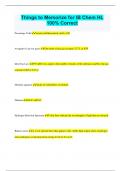
-
Things to Memorize for IB Chem HL 100% Correct
- Examen • 20 páginas • 2024
-
Disponible en paquete
-
- $9.99
- + aprende más y mejor
Things to Memorize for IB Chem HL 100% Correct Percentage Yeild actual yield/theoretical yield x 100 Avogadro's Law for gases One mole of any gas occupies 22.7 L at STP Ideal Gas Law PV=nRT (n is equal to the number of moles of the substance and R is the gas constant 0.082 or 8.314) Molarity equation moles of solute/liters of solution Dilution M1V1=M2V2 Hydrogen Emission Spectrum Color lines indicate the wavelengths of light that are released Balmer series A set of spec...
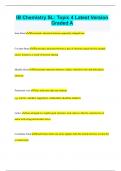
-
IB Chemistry SL: Topic 4 Latest Version Graded A
- Examen • 30 páginas • 2024
-
Disponible en paquete
-
- $10.49
- + aprende más y mejor
IB Chemistry SL: Topic 4 Latest Version Graded A Ionic Bond Electrostatic attraction between oppositely charged ions Covalent Bond Electrostatic attraction between a pair of electrons and positively charged nuclei, formed as a result of electron sharing Metallic Bond Electrostatic attraction between a lattice of positive ions and delocalized electrons Polyatomic ions ions with more than one element e.g. CaCO3, Al(OH)3, Mg(NO3)2, (NH4)2SO4, Ba3PO4, LiHCO3 Lattice ions arran...

-
IB Chemistry HL, full course notes
- Lote • 11 artículos • 2023
-
- $12.73
- 3x vendido
- + aprende más y mejor
In depth and simple to understand class notes taken over the course of 2 years in a highly accredited IB school for Chemistry HL. Notes by topic for all 11 core topics. This includes diagrams, annotations, extensive notes and explanations and they are the notes that have solely led me to an IB 7 in HL Chemistry. Please use them as best you can.

-
IB Chemistry SL Latest Update Graded A+
- Examen • 11 páginas • 2024
-
Disponible en paquete
-
- $8.99
- + aprende más y mejor
IB Chemistry SL Latest Update Graded A+ element a substance that cannot be broken down into simpler substances. atom smallest part of an element. compound substance that contains more than one element. empirical formula this shows the simplest whole number ratio of atoms of each element in a particle of the substance. molecular formula shows the actual number of atoms of each element in a molecule of the substance. structural formula this shows the arrangement of atoms an ...

-
IB Chemistry Topic 10 Questions and Answers Graded A+
- Examen • 14 páginas • 2024
-
Disponible en paquete
-
- $9.99
- + aprende más y mejor
IB Chemistry Topic 10 Questions and Answers Graded A+ All ________ compounds contain carbon, but ____ ____ carbon containing compounds are _______. organic, not all, organic Catenation Carbon can form long chains and rings, linked by single, double, or triple bonds. Hydrocarbon composed of only C and H atoms, the simplest organic compounds Empirical Formula simplest whole number ratio of atoms in the compound Molecular formula shows the actual number and types of atoms (multip...
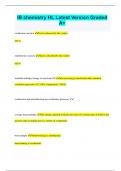
-
IB chemistry HL Latest Version Graded A+
- Examen • 9 páginas • 2024
-
Disponible en paquete
-
- $9.99
- + aprende más y mejor
IB chemistry HL Latest Version Graded A+ exothermic reaction heat is released by the system ΔΗ<0 endothermic reaction heat is absorbed by the system ΔΗ>0 standard enthalpy change of reaction(ΔΗ) the heat energy transferred under standard conditions (pressure-101.3 kPa, temperature- 298 K) combustion and neutralization are exothermic processes average bond enthalpy the energy required to break one mole of a certain type of bond in the gaseous state averaged acro...
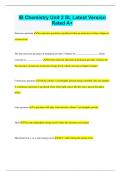
-
IB Chemistry Unit 2 SL Latest Version Rated A+
- Examen • 9 páginas • 2024
-
Disponible en paquete
-
- $9.99
- + aprende más y mejor
IB Chemistry Unit 2 SL Latest Version Rated A+ Emission spectrum An emission spectrum is produced when an atom moves from a higher to a lower level. The line emission spectrum of hydrogen provides evidence for __________________ which converge at _____________ The line emission spectrum of hydrogen provides evidence for the existence of electrons in discrete energy levels which converge at higher energies. Continuous spectrum All the colours / wavelengths present merge smoothly in...
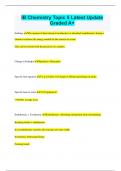
-
IB Chemistry Topic 5 Latest Update Graded A+
- Examen • 7 páginas • 2024
-
Disponible en paquete
-
- $8.99
- + aprende más y mejor
IB Chemistry Topic 5 Latest Update Graded A+ Enthalpy The amount of heat released (exothermic) or absorbed (endothermic) during a chemical reaction (the energy needed for the reaction to occur) This can be lowered with the presence of a catalyst. Change in Enthalpy Hproducts -Hreactants Specific heat equation c= q in Joules (or Change in H)/mass(g)(change in temp) Specific heat of water 4.18 J/gdegreesC **NOTE: Usually in kJ Endothermic v. Exothermic Endothermic: Absorbing e...
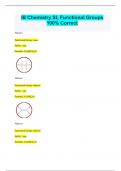
-
IB Chemistry SL Functional Groups 100% Correct
- Examen • 5 páginas • 2024
-
Disponible en paquete
-
- $8.99
- + aprende más y mejor
IB Chemistry SL Functional Groups 100% Correct Alkanes Functional Group: none Suffix: -ane Formula: C(n)H(2n+2) Alkenes Functional Group: alkenyl Suffix: -ene Formula: C(n)H(2n) Alkynes Functional Group: alkynyl Suffix: -yne Formula: C(n)H(2n-2) halogenoalkanes Functional Group: —X ( X= F, Br, Cl, I) Suffix: none Formula: C(n)H(2n+1)X arenes Functional Group: phenyl Suffix: none Formula: C(n)H(2n-6) alcohols Functional Group: hydroxyl Suffix: -ol Formula:...

¿Cuánto te has gastado ya en Stuvia? Imagina que sois muchos más los que estáis ahí fuera pagando por apuntes de estudio, pero esta vez TÚ eres el vendedor. ¡Ka-ching! Descubre todo sobre cómo ganar en Stuvia



